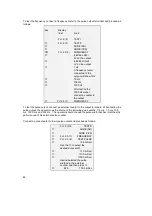
89
9.7
Fault finding
Most of the common faults and symptoms experienced with the flowmeter can be resolved
with the help of the following table.
To simplify the use of the table, the faults and symptoms are grouped together:
GROUPS
D
Display, inputs and outputs
I
Current output
P
Pulse output
A
Alarm output (Status)
E
Control input (Binary)
OP
Measurement mode and commissioning
ST
Commissioning and Start-up of the flowmeter
Group
Fault / Symptom
Cause
Remedy
Group D
D1
No display or outputs
Power not switched on
Switch on power
Power supply fuse F9
blown
Replace fuse as per
Section 9.3.1
Fuses F10, and/or
F12 blown
Replace converter as per
Sect. 9.2 or call Krohne
service.
D2
Fluctuating display and
outputs
Time constant too small
Increase time constant as
per Section 6.3.
D3
Mass flow display
incorrect
The wrong value for
parameters CF5 (GK)
programmed. (This is
stamped on the data plate)
Check and correct
according to
Sections 6.12 and 6.14.4
Zero calibration
Re-do zero, check manual
offset
Primary sensor faulty
Check as per Section 9.8
D4
Density display and
outputs not correct
Density Parameters
Check and correct
according to 6.12
Excitation frequency of
primary sensor not correct
when filled with water (see
section 2.7.3)
Check for air in meter.
Call Krohne.
Primary sensor faulty
Check as per Section 9.8
Group I
I1
Connected instrument
displays 0 or negative
values
Connection polarity
wrong
Correct as per Sect. 3.3
Connected instrument
faulty or current output
faulty
Check output with a mA
meter.
I Test OK
Check cabling and
connected instrument and
replace if necessary.
I Test faulty
Current output faulty.
Replace converter or call
Krohne service.
Please check the following table of hints and advice
before calling your KROHNE Service Department.















































